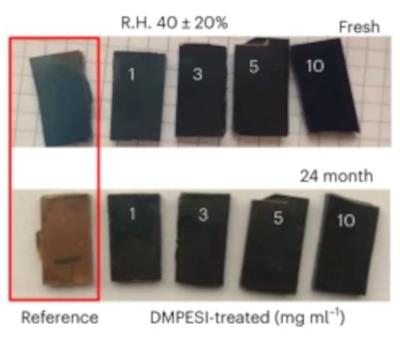A collaborative team of researchers, including ones from Uppsala University, CNR-SCITEC, Fraunhofer ISE, University of Cambridge, Empa, EPFL and additional institutes, recently introduced an unexplored dimethylphenethylsulfonium iodide (DMPESI) molecule to post-treat formamidinium lead iodide perovskite films. The treated films showed outstanding stability upon light soaking and remarkably remains in black-phase after 2 years ageing under ambient condition without encapsulation.
Fresh and 24-month aged unencapsulated perovskite film (1.0 cm by 2.0 cm) without and with DMPESI treatment of different concentrations. Image from Nature Energy
The DMPESI-treated PSCs deliver a breakthrough record in operational stability of highly-efficient PSCs with less than 1% performance loss after more than 4500 h at maximum power point tracking, yielding an extraordinarily high theoretical T80 of over 9 years under continuous 1-sun illumination, which would correspond to a photon flux of an outdoor PV installation in Sweden or Germany (1,000 kWh m−2 per year) of over 78 years.
The PSCs also present less than 5% PCE drops under various ageing conditions (including thermal cycling and damp heat test). Such excellent durability of DMPESI-treated perovskite film as well as the PSC devices provides a strong indication that perovskite thin films have enormous potential to fulfill industrial protocols and compete with Si-based solar cells for further large scale and industrial productions.
e) Long-term operational stability of the unencapsulated control and treated devices under MPPT with continuous 1-sun illumination under N2 flow at room temperature. The linear fitting of DMPESI-treated device maximum power point stability, the initial device PCE is 22.68% (DMPESI treated) and 20.43% (control). f) Operational stability of state-of-the-art highly efficient (PCE > 22%) PSCs extracted from literature.
Uppsala University's Bowen Yang, co-author of the recent paper, said: "I believe this is a valuable step forward in the scale-up of perovskite solar cells and will lead to significant follow-up research as this work is developed and adopted in different architectures".



